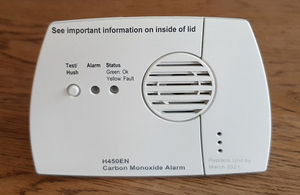Carbon monoxide detector
Carbon monoxide (CO) is a colourless, tasteless and odourless gas that is highly poisonous. It can cause serious damage to health if inhaled over a long period, and can quickly cause neurological damage, paralysis or death.
Carbon monoxide is produced when a combustion appliance such as a boiler, heater, oven, and so on, does not completely burn a carbon-based fuel. This might include fuels such as; gas, oil, paraffin, coal, wood or charcoal. Typically, fuel might not be completely burned if an appliance has been incorrectly installed or maintained or if vents, chimneys or flues are blocked. It may also enter a property through shared chimneys or flues.
If a building is powered entirely by electricity, a carbon monoxide detector is not necessary, but there should be one in every room in a building where there is a fuel-burning boiler, fire, or stove.
Because carbon monoxide is colourless, tasteless and odourless, people may not notice it, but it can be detected by a carbon monoxide detector. Typically, an audible alarm is sounded if carbon monoxide is detected.
There are several different types of carbon monoxide detectors/alarms:
- A standalone unit
- A combined unit that also operates as a smoke detector.
- Sealed battery: Batteries are sealed inside the detector and an alarm sounds when they run out.
- Replaceable battery: Batteries will need replacing every 2-3 years.
- Smart detector: Alerts the occupant via their smartphone as well as triggering the alarm.
- Patch: This is a cheaper option which changes colour if there is carbon monoxide in the atmosphere, however, this is less safe as it does not sound an alarm.
Detectors should have a EN 50291 mark and a British Standards' Kitemark (or equivalent European mark). They should be installed in accordance with manufacturers’ instructions, typically at head height in each room with a combustion appliance. They should be tested regularly, and batteries replaced as required.
Since 2010, the building regulations have required that carbon monoxide alarms are installed in properties where a replacement, or new fixed solid fuel burning appliance is installed.
In 2015, the government introduced new regulations requiring private rented sector landlords in England to instal a carbon monoxide alarm in any room used as living accommodation where solid fuel is used. Detectors must be tested at the start of each tenancy, and penalties for failure to comply can be up to £5,000.
[edit] 2018 review
In April 2018, the Government announced it was undertaking a review of rules that require carbon monoxide alarms to be fitted in homes across England when solid fuel appliances such as wood burning stoves and boilers are installed. The review will examine the regulations to establish whether they remain fit for purpose and will consider new research into the number of carbon monoxide poisonings and whether the rate of installation is being affected by the cost of alarms. (Ref. https://www.gov.uk/government/news/government-to-launch-review-into-carbon-monoxide-alarms)
[edit] Related articles on Designing Buildings Wiki
- BS EN 50291.
- Carbon monoxide
- Carbon monoxide Requirement J3.
- Combustion appliance.
- Fire detection and alarm system.
- Gas Safe.
- Glass break detector.
- Heat alarm.
- Homes (Fitness for Human Habitation) Act 2018.
- Interlinked fire alarm safety laws in Scotland.
- Intruder alarm.
- Ionisation smoke alarm.
- Mains gas.
- Multi-sensor alarm.
- Over £1 billion lost every year due to false alarms.
- Smoke damper.
- Smoke detector.
- Types of domestic boiler.
Featured articles and news
Infrastructure that connect the physical and digital domains.
Harnessing robotics and AI in challenging environments
The key to nuclear decommissioning and fusion engineering.
BSRIA announces Lisa Ashworth as new CEO
Tasked with furthering BSRIA’s impressive growth ambitions.
Public buildings get half a million energy efficiency boost
£557 million to switch to cleaner heating and save on energy.
CIOB launches pre-election manifesto
Outlining potential future policies for the next government.
Grenfell Tower Inquiry announcement
Phase 2 hearings come to a close and the final report due in September.
Progress from Parts L, F and O: A whitepaper, one year on.
A replicated study to understand the opinion of practitioners.
ECA announces new president 2024
Electrical engineer and business leader Stuart Smith.
A distinct type of countryside that should be celebrated.
Should Part O be extended to existing buildings?
EAC brands heatwave adaptation a missed opportunity.
Definition of Statutory in workplace and facilities management
Established by IWFM, BESA, CIBSE and BSRIA.
Tackling the transition from traditional heating systems
59% lack the necessary information and confidence to switch.
The general election and the construction industry
As PM, Rishi Sunak announces July 4 date for an election.
Eco apprenticeships continue help grow green workforce
A year after being recognised at the King's coronation.
Permitted development rights for agricultural buildings
The changes coming into effect as of May 21, 2024.






















